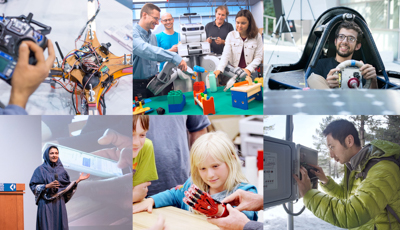On December 9, CITRIS and the Banatao Institute hosted a virtual town hall to reflect on how the University of California research community has developed […]
UC Berkeley
Women in Tech Holiday Gift Guide 2020
The Women in Tech Initiative at the University of California has developed a 2020 Women in Tech Holiday Gift Guide to boost and support the persistence […]
CITRIS Foundry Spring 2021 Cohort Application now open
The spring 2021 cohort application is now open for the CITRIS Foundry Innovation Incubator. Receive the resources, mentorship, and connections needed to translate your innovation […]
CITRIS Health Director David Lindeman appointed to the California Commission on Aging
CITRIS Health Director David Lindeman has been appointed to the California Commission on Aging by Governor Gavin Newsom. Lindeman has worked in the fields of […]
CITRIS Invention Lab Superuser Spotlight: Hailey Windsor (Class of ’20, CED)
Hailey Windsor was introduced to the CITRIS Invention Lab as a freshman and found a place where she could combine her interests in environmental design, engineering, art, and new media. In the lab, Windsor worked with Visualize, a nonprofit organization co-founded in 2014 by Julia Kramer (PhD 2020 ME) and Loyola University medical student Maria Young, prototyping training devices for nurses in Ghana to identify cervical cancer. Windsor also had the opportunity to work with the Berkeley AI startup Covariant.ai. She graduated from UC Berkeley in spring 2020 with an Individual Major in Human-Centered Design.
CITRIS Invention Lab Superuser Spotlight: Lieyah Dagan (Class of ‘18, CED)
Lieyah Dagan graduated from UC Berkeley in 2018 with an individual major in Design for Urban Life, which explored a variety of fields, including art, architecture, design, and fashion. She currently works as an Industrial Designer. She was first introduced to the CITRIS Invention Lab when she took Critical Practice and Critical Making with EECS Professor and CITRIS Invention Lab Director Eric Paulos for her concentration in design.
CITRIS Policy Lab Director Brandie Nonnecke feature on CompilHER podcast
On October 20, CITRIS Policy Lab Director Brandie Nonnecke was featured on the technology podcast, CompilHER, to discuss online election integrity and data protection issues. […]
Four Strategies to Combat Disinformation Before Elections
California laws passed to stop disinformation will likely be ineffective. Here are four strategies that should be implemented. Earlier in October, the US Department of […]
CITRIS Invention Lab Superuser Spotlight: Uzoma Nwakuche (Class of ‘21, EECS)
Uzoma Nwakuche is a senior studying Electrical Engineering and Computer Science at UC Berkeley. When he was younger, Nwakuche attended UC Berkeley summer camps and […]
CITRIS Invention Lab Superuser Spotlight: Daniel Lim (Ph.D. Student, ME)
Daniel Lim received his Master of Engineering in Mechanical Engineering from UC Berkeley in 2015. He was also a UC Berkeley Ph.D. student from 2016-2018 […]
CITRIS Invention Lab Superuser Spotlight: Tomas Georgiou (Ph.D. candidate, ME)
Tomas Georgiou is a Ph.D. candidate in mechanical engineering at UC Berkeley. Hailing from Minnesota, Georgiou earned his undergraduate degree in aerospace engineering at the […]
CITRIS Invention Lab Superuser Spotlight: Eldon Schoop (PhD, CS)
Eldon Schoop is a Ph.D. student in computer science at UC Berkeley. He first saw the CITRIS Invention Lab through the Berkeley Engineering T-PREP program […]
2 UC Berkeley makerspaces provide remote access to services amid COVID-19 pandemic
Daily Cal: In response to the COVID-19 pandemic, the makerspaces of UC Berkeley’s CITRIS Invention Lab and Jacobs Institute for Design Innovation have added remote […]
Grace Hopper Celebration: Finding a Job when AI is “Hiring”
A Recap of Women in Tech Initiative Director Jill Finlayson’s Grace Hopper Celebration 2020 Session Increasingly, AI-enabled tools are used in every facet of the […]
Top 10 Cybersecurity Tips for National Cybersecurity Awareness Month
October is National Cybersecurity Awareness Month (NCSAM). Now in its 17th year, NCSAM continues to raise awareness about the importance of cybersecurity across our Nation, […]
The Risks and Rewards of Emerging Technologies within Public Services
Investments in digital infrastructure in the public sector have lagged for years. The COVID-19 pandemic has torn back the curtain to reveal a dilapidated IT […]
CITRIS Invention Lab Superuser Spotlight: Nicole Repina (Ph.D., Bioengineering)
Nicole Repina is a recent Ph.D. graduate from UC Berkeley bioengineering. She is originally from Boston and earned her undergraduate degree in biochemistry and molecular […]
Announcing the new Fall 2020 Women in Tech Initiative DeCal Course
The Fall 2020 Women in Tech Initiative Decal Course Opportunities and Barriers is for students who want hands-on experience in creating projects that advance diversity and […]
Women in Tech Initiative’s Fall 2020 URAP project
UC Berkeley students are encouraged to apply to be part of the Women in Tech Initiative’s Fall 2020 URAP research project on equitable participation for […]
CITRIS Foundry welcomes 10 teams for Summer 2020 Cohort
The CITRIS Foundry welcomes ten new teams covering a variety of tech fields from artificial intelligence (AI) and augmented reality (AR) to 3D mapping and […]
Getting your startup off on the right foot–Easy ways to better hiring
Better hiring: Do you want investment? Do you want top talent? Do you want great products? Do you want profitability? Of course your answer is […]
Blockchain for the public good
Over the last year, I have had the privilege to lead the California Blockchain Working Group, which delivered its report to the Legislature in early July. Established by AB […]
C3.ai Digital Transformation Institute Announces COVID-19 Awards
26 Projects Awarded $5.4 Million to Accelerate Artificial Intelligence Research for COVID-19 Mitigation Across Medicine, Urban Planning, and Public Policy Urbana, IL and Berkeley, CA — […]
Campus charging station a new testbed for EV research
Scott Moura, CITRIS PI and associate professor of Civil and Environmental Engineering, heads up the SlrpEV Charging Station project (Smart LeaRning Pilot for Electric Vehicles). This summer, […]























